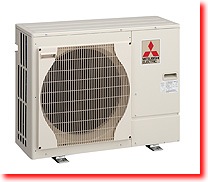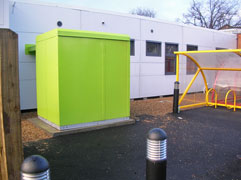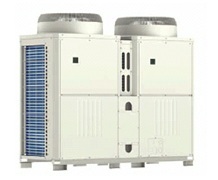Air Source Heat Pumps – ASHP – Space Heating
An Air Source Heat Pump (ASHP) can be an efficient means of saving money and saving carbon emissions if carefully designed for space heating of an appropriately designed building.
The first priority should be to ensure that the building is well insulated (and well managed). All new buildings should have high insulation built in and be well constructed to minimise heat loss through air leaks.
Because an ASHP is more efficient when producing a lot of warmth – as opposed to a small amount of heat – the distribution system in the building should match this: a large area of underfloor heating distributing warmth is more efficient than a small area of radiators emitting high temperatures (and causing draughts).
ASHP – Coefficient of Performance – CoP
The key to the efficiency of a heat pump is the Coefficient of Performance: the “CoP”. In spite of the first law of thermodynamics, which tells us that energy can neither be created nor destroyed, an ASHP in a good installation can transfer up to three units of heat for each unit of electricity consumed. The heat pump is not creating this energy, but merely separating a medium temperature from the external air into warmth (which can be used for heating) and cold (which can be returned to the atmosphere).
The CoP will vary with each installation, but the lower the output temperature to the heat distribution system the higher the CoP will be. If an output temperature of 60°C is needed to heat radiators the CoP may fall to level of only 2.0. If the heat distribution is to a well designed underfloor heating system that works well at an output temperature of 40°C then the CoP can rise to a level of 3 in the winter (and higher in the spring and autumn).
The input temperature is also critical to the CoP of the heat pump. The higher the input temperature from the air, the lower the amount of work needed from the heat pump, the higher the CoP will be. In fact, the critical factor is the “uplift” between the source temperature and the output temperature. Therefore an ASHP is more efficient in the autumn or the spring than in the depths of winter.
Advantages of Heat Pumps
Heat pumps save money. Heat pumps are cheaper to run than direct electric heating. They are cheaper to run than oil boilers and can be cheaper than running gas boilers. Because heat pumps can be fully automated they demand much less work than biomass boilers.
Heat pumps save carbon emissions. Unlike burning oil, gas, LPG or biomass, a heat pump produces no carbon emissions on site (and no carbon emissions at all, if a renewable source of electricity is used to power them).
Heat pumps save space. There are no fuel storage requirements.
Heat pumps are safe. There is no combustion involved and no emission of potentially dangerous gases. No flues are required.
Heat pumps require less maintenance than combustion based heating systems.
Heat pumps can provide cooling in summer, as well as heating in winter.

Advantages of Air Source Heat Pumps
The chief reason for using an ASHP rather than a Ground Source Heat Pump (GSHP) is that they are cheaper and quicker to install, because you save the cost of installing a "ground loop heat exchanger" in the ground.
An air source heat pump can provide efficient net zero heating to homes which have no access to the ground for heat exchange.
Disadvantages of Air Source Heat Pumps
An ASHP has no access to an interseasonal heat store in the ground – it cannot take advantage from the fact that higher temperatures are available from the ground in winter than from ambient air. It is therefore less efficient than a ground source heat pump in winter and suffers from a lower coefficient of performance. It needs to spend energy (and generates noise) on a fan system to blow air across its heat exchangers. It also needs to incorporate a defrost cycle to prevent ice forming on its heat exchangers in cold conditions (when heat is most needed).
Advantages of Ground Source Heat Pumps
The key advantage of using a GSHP is that the coefficient of performance is higher than an ASHP in winter, because the temperature in the ground is higher than the ambient air temperature. Planning permission is also easier as a GSHP can be located out of sight and makes virtually no noise. As a GSHP has fewer moving parts it may also enjoy a longer working life.
Advantages of using Interseasonal Heat Transfer
An Interseasonal Heat Transfer installation is considerably more efficient than an unassisted GSHP because an IHT system draws heat from a warm Thermalbank instead of drawing heat from cold ground.

Interseasonal Heat Transfer and Heat Pumps
ICAX has introduced a radical new mechanism for collecting surplus solar heat in the summer, storing it in Thermalbanks, and releasing it via heat pumps to heat buildings in winter: Interseasonal Heat Transfer.
By using ThermalBanks for thermal energy storage ICAX enables its heat pumps to start with a ground temperature of 25°C, instead of starting with an autumn ground temperature of 10°C. This doubles the CoP of the heat pump from the standard figure of 4 up to 8 and transforms the economics, and carbon saving, of using a GSHP.
See also: GSHP Breakthrough
See also: Banking on IHT
See also: Renewable Cooling
See also: Ground Source Energy
See also: Professor David MacKay endorses heat pumps
See also: RHI - Renewable Heat Incentive



